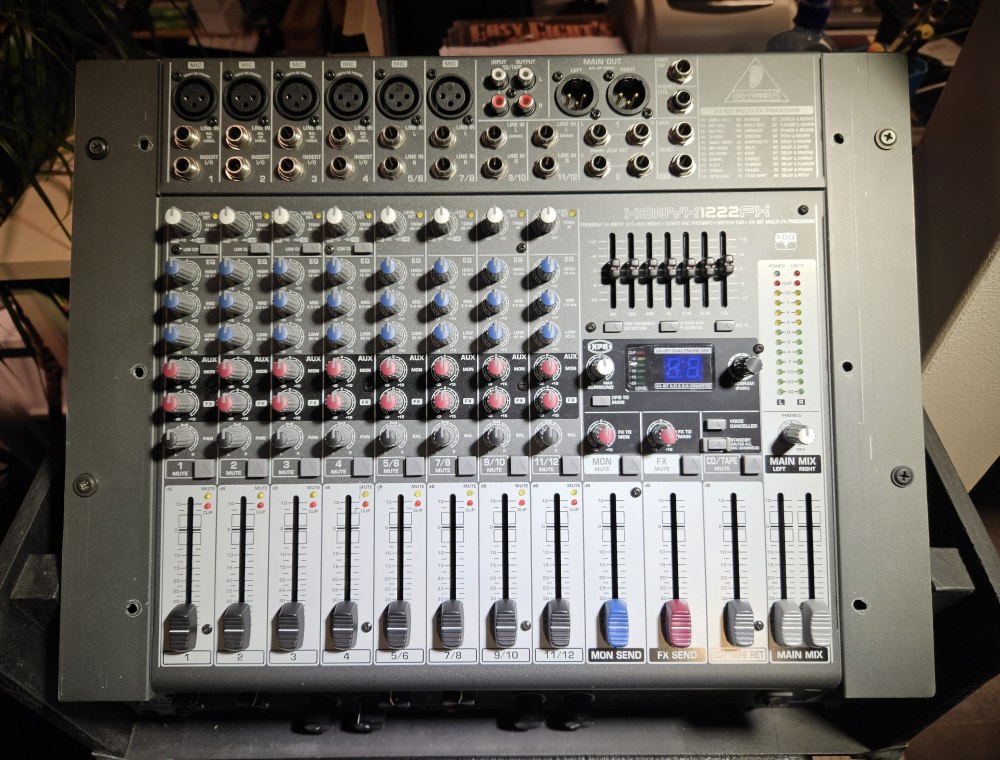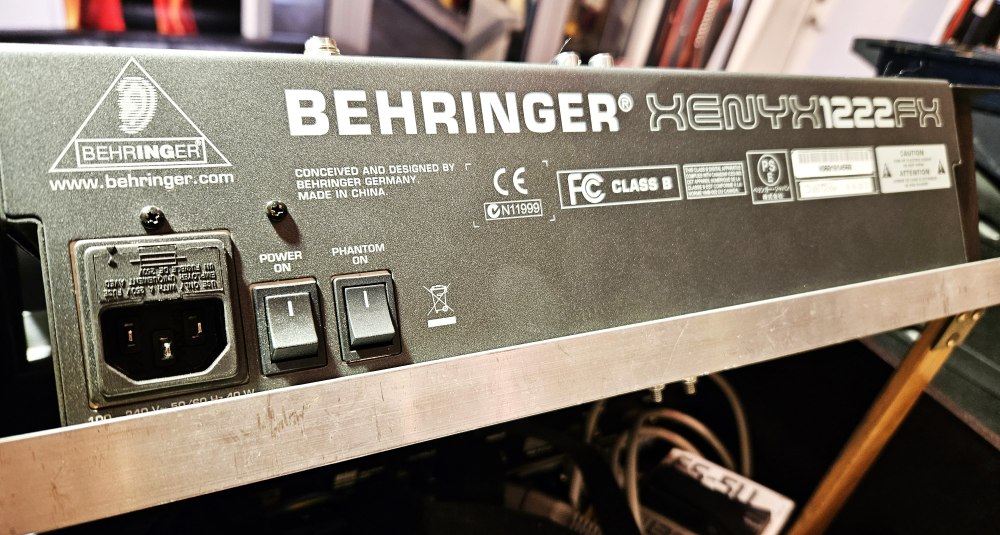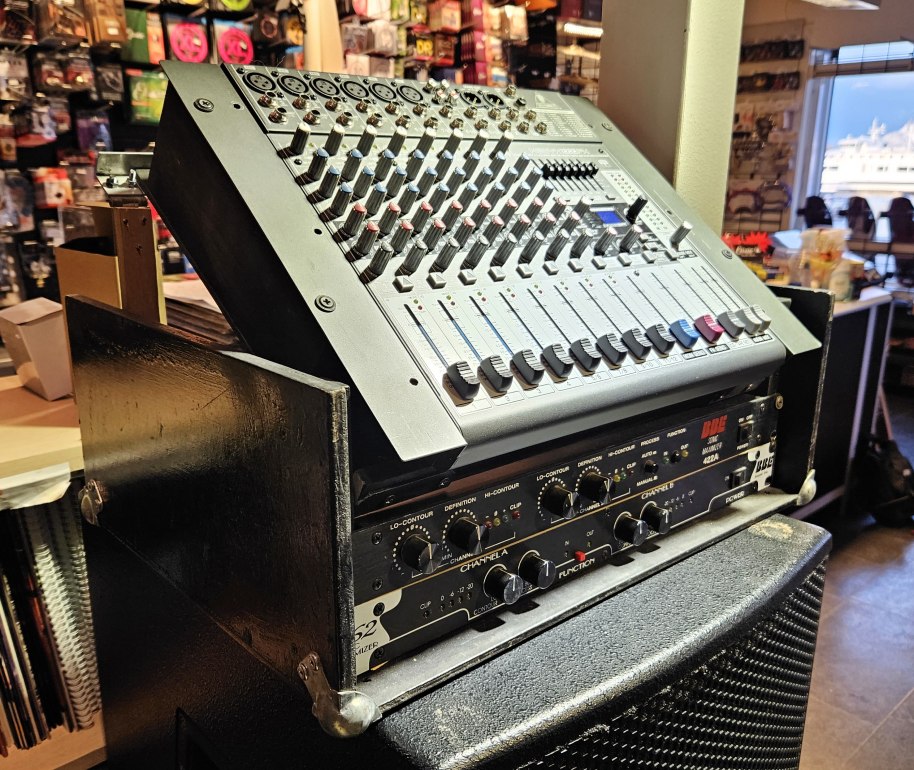Beskrivelse
Mikser pakkeløsning Behringer XENYX 1222FX og BBE Sonic Maximizer 462 og 422 i en enkel rack løsning.
Behringer XENYX 1222FX
Premium 16-Input 2/2-Bus Mixer with XENYX Mic Preamps, British EQ, 24-Bit Multi-FX Processor and USB/Audio Interface
Superior Mic Preamps
The BEHRINGER XENYX 1222FX represents a significant milestone in the development of mixer technology. Equipped with our premium XENYX mic preamps, it can easily hold its own against expensive stand-alone mic pres, both in terms of sound quality and available headroom. XENYX preamps offer a staggering 130 dB of dynamic range, with a bandwidth that extends from below 10 Hz to well above 200 kHz.
These preamps provide such transparent, crystal-clear performance you just might think someone upgraded your mics. And thanks to available onboard phantom power, you can deploy studio-quality condenser mics — pretty cool for drum overheads and tracking vocals in the studio.
Sublimely Musical “British” EQ
The British consoles of the 1960s and ‘70s changed the sound of rock and roll — without them, the “British Invasion” might not have happened. Those legendary mixing desks soon became the envy of engineers and producers all over the world. The EQ on our new XENYX Series mixers is based on that very same circuitry, allowing you to infuse signals with incredible warmth and detailed musical character. Even when pushed to extreme settings, these equalizers exhibit superb audio quality.
All channel strips on the 1222FX feature HIGH and LOW filters of the shelving variety, with cut-off frequencies of 12 kHz and 80 Hz respectively. The MID band is configured as a peak filter with a center frequency of 2.5 kHz.
BBE Sonic Maximizer Model 462
BBE’s Sonic Maximizer has been with us for several years now, earning itself a reputation as one of the sweeter sounding enhancers on the market. Paul White studio tests the latest incarnation, the 462, which benefits from extensively redesigned circuitry.
When Aphex first invented the Aural Exciter, they can have had little idea that their work would inspire a whole genre of sonic enhancers, based on a wide range of operating principles. The patented Aphex process works by synthesizing additional high frequency harmonics related to the original signal, but BBE chose to travel a different route, basing their process on a combination of dynamic equalisation and phase manipulation. To augment the high frequency enhancement of the BBE process, the new Model 462 features a Lo Contour control which adds power to the bass end of the spectrum. Few details are provided to explain how this works, but reading between the lines, it appears to be another form of dynamic equalisation.
For those unfamiliar with dynamic equalisation, here’s how it works: imagine an equaliser whose level of boost is related to the level of the signal being treated. When there’s no signal present, there’s no boost, and when the signal level is high, maximum boost is applied. Such an approach has many advantages; it can help emphasise transient sounds without adding any noise when the input signal is low, as would be the case with a conventional boost equaliser.
The phase manipulation side of the process is described as a linear phase shift across the whole audio spectrum corresponding to a delay of under 2ms. This is intended to prevent the high frequency detail from being smeared by the low frequency components of the sound and increases definition without boosting level.
Housed in a mains powered, 1U rack case, the BBE 462 is a true two‑channel device with just two controls per channel. Both phono and unbalanced jack connections are provided for signal connection and the system has sufficient headroom to work with either ‑10dBV or +4dBu signals. Each channel is equipped with a simple LED metering system which monitors the output level of the unit, and the Bypass button operates on both channels simultaneously.
Unlike the early Aphex units and similar enhancers, there is no need to set up a Drive level; once the unit has been patched in (ideally via insert points), the BBE’s Process control is used to add brightness and clarity while the Lo Contour control allows for either bass enhancement or bass cut in the 50Hz region of the spectrum. In its centre position, the Lo Contour control contributes nothing to the sound, boost only being applied as it is advanced clockwise from this position. Anti‑clockwise of centre, the control acts as a bass cut. As long as the level meters stay below the clipping level, all that’s required is to adjust the control until the sound is ‘right’.
Since the operating principle of the 462 is based on dynamic equalisation, the end result depends very much on the dynamics of the incoming signal. For example, used on a constant level ‘pad’ sound, the result isn’t far removed from what you’d expect when using a conventional equaliser. Conversely, a dynamically active signal such as a drum track or percussive bass line is treated in a far more positive manner. Transient details — such as snare drum beats and cymbal hits — take on extra sparkle, while more subtle sounds — such as reverb and intricate keyboard textures — seem to open up, allowing the individual sounds in a mix to shine through rather than burying each other. Similarly, the bass enhancement helps to make a bass line or bass drum sound punchy without unduly clouding what goes on between the beats.
How does the BBE process stand up to competing approaches to enhancement? On the plus side, the BBE process offers smoothness and quietness. Low level sounds are left untreated, so you don’t tend to get an increase in background noise during quieter passages, while at higher settings the sound doesn’t develop the raw edge that some types of enhancer seem to generate. If used to excess, the sound can become obviously equalised and even a little ‘honky’ in character, but it never actually becomes rough. On the downside, the very fact that the BBE process doesn’t generate any new harmonics means that it is less capable of revitalising an overtly dull sound; it still has to work on what is already there.
On balance, the BBE process has proved itself over the years to be both flexible and controllable with many applications — from overall mix sweetening to beefing up individual instruments or voices in a mix. Personally, I feel that the BBE process works best where the existing sound source is already 95% right, allowing the Sonic Maximizer to add the final gloss without interfering with the underlying character of the sound. If your original material is noticeably limp or dull, however, then one of the less subtle enhancement processors might prove better at achieving the desired result.
Sonic Maximizer Applications
- Adding depth and detail to a complete mix.
- Creating a slightly over‑bright master for cassette duplication.
- Making percussive sounds stand out in a mix.
- Adding depth and intimacy to vocals.
- Creating perspective in a mix by selectively treating sounds.
- Adding low‑end punch to dance material.
BBE 422 SONIC MAXIMIZER
The Sonic Maximizer is a dual channel enhancer designed to operate with -10dBu levels. It works by applying phase correction to the high frequencies which it does by splitting the sound into 3 bands, crossover frequencies being 150Hz and 1200Hz, and applying delays to the two lower bands. The high band passes through a VCA and is controlled in relation to the mid band. There are two modes – ‘Auto’ mode provides dynamic response so that the 422A expands or compresses the high band in relation to the mid, while in ‘Manual’ a factory preset expansion ratio is applied. Each channel has a Lo-contour and a Definition knob. Lo-contour is for bass EQ at 50Hz, Definition regulates the processing of the high band in relation to the mid and effectively adds more top end.

























